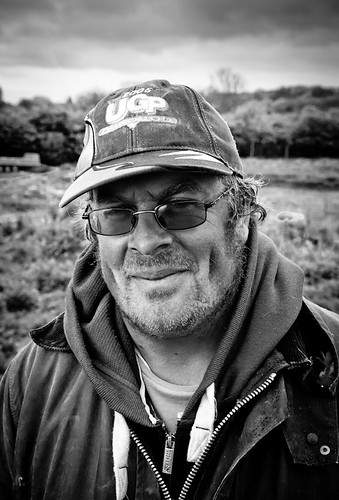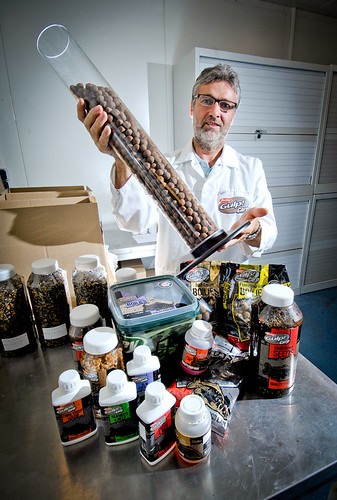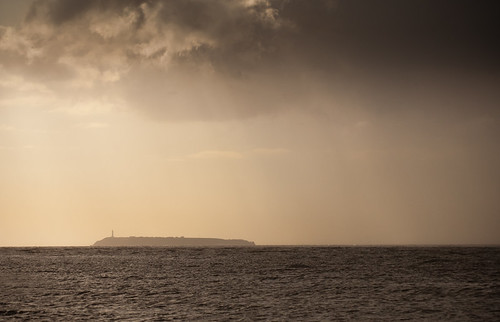It's always exciting when editors work with you on a concept, especially when it comes to covers that push the envelope.
Traditionally, our fishing mag covers have always featured a man with fish, a man with a net of fish, or on odd occasions, a man playing a fish. However, the new editor of TCF really wanted to create a 'hero' shot that would stand out on the crowded newsstand so we took our lead from an issue of Field & Stream where a hunter was nicely lit holding his hunting equipment. We decided to use a different kind of 'hunter', well-known predator angler Mick Brown.
The studio space at work is 'bijou' to say the least so we had to work around the amount of working area; to camera left are two 24" soft boxes stacked on top of each other to replicate a strip box for soft fill, and you can see the other two lights and what they're achieving.
There's obviously a considerable crop taken place to fit the image on the cover, plus some heavy Photoshopping. However, as a cover that stands out from the crowd I'm really pleased with what we achieved.... sales will tell if we made the right decision, but nonetheless we've produced something we can be proud of.
*Nikon D7000
*Nikon 17-55mm f/2.8
*ISO 100
*1/250th @ f/7.1
Tuesday, 18 December 2012
Magazine cover concept
Wednesday, 12 December 2012
Robin
Just a quick snap from today's feature with Bob Nudd for UK fishing magazine, Total Coarse Fishing.
This cheeky little robin was doing the usual winter trick - look cute and then steal maggots form your bait tray. I couldn't begrudge him that when he was so willing to model for the camera!
*Nikon D7000
*Nikon 70-200mm VR
*ISO 1600
*1/320th @ f/4
Wednesday, 21 November 2012
New Toy...
Tuesday, 28 August 2012
REVIEW: Nikon 300mm f/4 AF-S
Wednesday, 1 August 2012
More work! Yes please....
Tuesday, 15 May 2012
It's good to cheat....
Today I was out for a carp fishing magazine and with the weather being crap, we had tiny windows in-between the rain to get shots done. One shot on the list was feeding bait into the margins. I knew the focus was on the splash of the bait so threw the angler out of focus in the background using f/2.5. Unfortunately, when you're working quick like this you do hit upon mistakes that you don't realise until you get back to base.
In this case the best splash had the angler, Rik, with his throwing arm by his side so it just looked like some random stuff hitting the water. I knew I had another shot with his arm outstretched so that was a good starting point to do a merge.
I rarely use a tripod because I work quickly so there was obvious discrepancy in the angle of the horizon between shots. Thankfully, I'd shot wide to give some room for cropping. However, with the wind howling, the reeds where the bait was hitting was blowing all over the place and didn't stay still between shots.
In Photoshop I overlaid the shots then applied a layer mask so I could uncover parts of one shot yet leave in bits of another. This merge is relatively straight forward; a gradient mask and then a bit of brushwork to tidy things up. The result is acceptable and although it's been Photoshopped, I don't class it as a fake - it's just a shot that I improved from circumstances that were hard to shoot in.
Sunday, 13 May 2012
Making A Magazine Feature
I'm quite trigger-happy while I'm out on shoots, working on that little-known adage of 'more is more'. I ALWAYS make sure that I have more images than I need, whether that's the same shot from a variety of angles, or just different exposures of the same shot, with differing light, aperture values and ISOs thrown into the mix. It's all about covering your arse as much as possible and making sure that you give the editorial staff and design team enough material to work with. Keep them sweet and things are good!
To explain, I've revisited a shoot I did at the start of the year;
The angler, Ade Kiddell, is experienced and very willing to do whatever I tell him to do, whether that's re-casting several times or just holding a fish as I want. Anglers like this are a joy to work with. A journalist was in attendance - I rarely do any editorial writing these days - so that also made my life a bit easier because we could talk about the brief on the way there and adapt it as we saw fit through the day.
Anyway, we'd come to the River Wensum to shoot a piece on bread fishing. The fishing wasn't going to be easy but we had a chance of chub - in fact, Ade had one pretty much straight away so that was the important part done. Thankfully, chub deal with being keep netted quite well so he was retained for more shots later. It's always nice to get at least one fish in the bag when you're doing features about bigger fish, because it puts me at ease and allows me to focus on the incidentals and sequence shots.
So, the feature gets wrapped up after having a few fish and doing all the shots we'd talked about. Job done so far but then it's a case of working out what images work best. My instructions for the the types of shots depend on the magazine; some editors want things shot in a specific manner, but most just let me take creative control. We knew a pic of a big chub would work well, especially at a time of year (March issue) when big fish weren't exactly throwing themselves on the bank to be photographed. I also had to make sure sequences were submitted, plus some incidentals of Ade fishing, casting, netting, holding up tackle etc...
The images are loaded into Lightroom 3 and then the key wording and metadata is synced, then it's a case of selection. As you can see from the screen shot, there are 139 images in this specific folder; not a massive shoot by any stretch, but enough to gee me plenty of options. The ones of out-of-focus grass and the backs of people's heads while setting up flashes are rejected and then I go through and from each set of shots, I pick the best one, giving it a five-star rating. These 'keepers' are selected by how they'll process, how the focus and depth-of-field look and whether facial expressions and such-like are acceptable.
Once I have my five-star images I then get to work doing adjustments; sharpening, fill adjustment with black point and contrast are typical ones, as is noise reduction. I rarely crop or straighten, because the designer is going to be placing the images so they may end up as cut-outs and the horizon won't appear anyway.
Then it's a case of the editor teaming the images up to the copy (the text) and submitting his final choice in a job bag to the designer with any instructions about image placement, sequences and which images are available as main (opening) images.
As you can see by the final feature, the 'grip-and-grin' of the angler with a fish made the opening spread, with sequences and incidentals over the remaining spread. Am I happy? Yes, and I know that my editing procedure ultimately influenced the images that made it into the feature. Job done :)
Wednesday, 9 May 2012
Peter
Took this today while out on a shoot in Essex at a trout fishery.
This is Peter, he's the fishery manager and a thoroughly nice bloke. Looks-wise he's a tad rough around the edges but as far as fishery staff go, he's one of the most welcoming I've met. Oh, and he also sound like Harry Hill.
EXACTLY like Harry Hill.
All I could think about was the knitted toy and people in crazy suits having fights on stage!!
*Nikon D2x
*Nikon 17-55mm f/2.8 AF-S
*ISO 100
*1/250th @ f/6.3
*SB-700 through softbox from camera left (power set to 1/8th)
*Processed in LR3
Monday, 16 April 2012
The Fishing Scientist
An old shot I unearthed while browsing my archive.
I took this during a trip to Berkley's Gulp bait factory in southern Holland. This was a press trip so there were all sorts of people who were trying to get shots of the chief scientist called Franz (or it could have been Frank - he dazzled me with science!).
Because of the melee of journos all wanting to get something for their mags, I had to work quickly so just set up an SB-800 in SU-4 mode behind him, with an SB-800 from camera right trigered by an Elinchrom Skyport. The shoot took about three minutes from start to finish before we headed out to the coach back to the airport.
Can't rememebr the settings but it was all manual obviously.
*Nikon D2x
*Nikon 12-24mm f/4
*ISO 200
*1/100th @ f/8
Although it did the job, this is the kind of shot I look back on and think "I wish I'd done it differently". The shot is fine in general and fitted what the mag wanted, but I know now that there needed to be more fill on the labels, the ambient needed to be dialled down in the background, and a gel on the rear flash could have given it more impact.
Still, it was true 'on-the-fly' indoor shooting, something I don't get a chance to do very often....
Sunday, 15 April 2012
Flatholm Island
Between massive thunderstorms and epic hail (and waiting for fish to bite) I thought I'd grab a shot of Flatholm, one of the islands that lie in the Bristol Channel.
*Nikon D2x
*Nikon 70-200mm f/2.8
*ISO 400
*1/4000th @ f/5.6

















